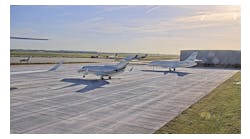7 Ways Your Airport is Getting Greener
Cleaner Jet Engines – Modern jet engines emit far fewer soot particles than earlier engines, reducing their contribution to the black exhaust typical of jet aircraft decades ago. New engine technologies also have reduced the amount of greenhouse gasses emitted per flight. The FAA just invested another $100 million to help reduce fuel use and emissions. Find more information here.
Smooth Arrivals – The FAA is “sliding” aircraft into airports with smooth arrival slopes instead of stair-step procedures. Optimized descents are saving millions of gallons of fuel and reducing CO2 and other emissions by hundreds of thousands of tons. Find more information here.
Riding on Batteries – With support from the FAA, airports across the country are exchanging their current trucks and buses for cleaner vehicles that run on electric fuel cells. These changes are expected to reduce ozone emissions by 1,703 tons per year for the next 5 years. Find more information here.
Harnessing the Sun – Airports such as Tucson International used FAA funding to install a field of solar panels that offsets about 50 percent of the energy needs for the airport’s terminal. The environmental benefits are equal to a reduction of 25,000 gallons of gas burned and 245 tons of carbon dioxide released per month. Find more information here.
Green Roofs – Vegetative coverings on airport building roofs have proved to be a successful way to decrease energy use through a reduction in the overall heat island effect, reduce storm water runoff, and provide acoustical buffering and air quality protection. You can find them in Seattle, Portland, Chicago and other locations. Find an example of a green airport roof here.
Rolling to the Runway – Jets will be rolling to the runway with a software capability that calculates gate pushbacks and will minimize taxi delay and ramp congestion, and reduce fuel burn and CO2 emissions. Watch the video.
Top it Off with Seaweed? – More planes will be using aviation fuels produced from renewable materials such as cooking oil, grease, wood waste, cornhusks, sugar cane and seaweed. Many planes won’t use fuel at all, as they switch to advanced electrical power. More details in the U.S. Aviation Climate Action Plan.





